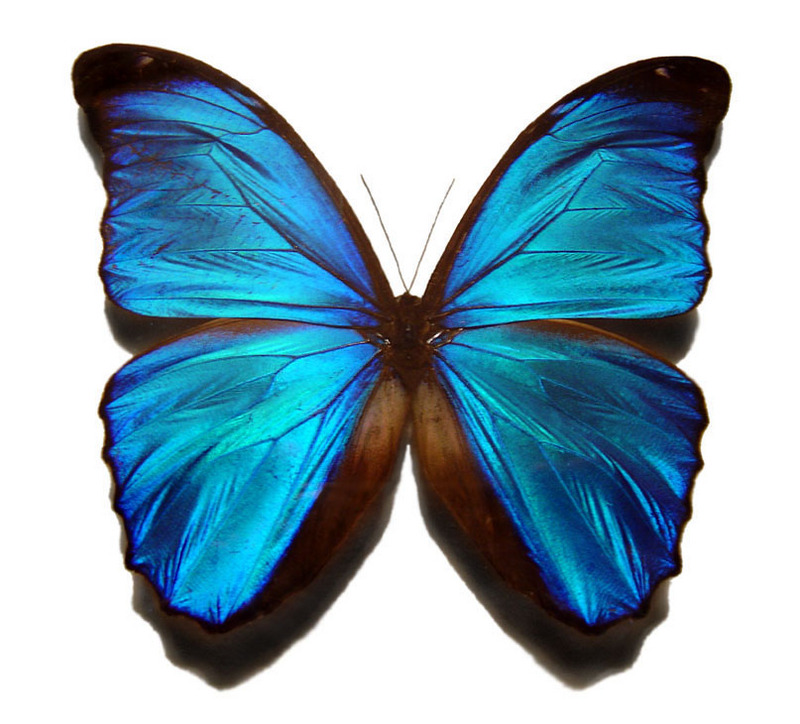Blue Morpho (Genus Morpho) - Wiki Morpho (butterfly)
From Wikipedia, the free encyclopedia
[Photo] Photograph of a Blue Morpho butterfly (Morpho menelaus) by Gregory Phillips http://en.wikipedia.org/wiki/user:hadal. Prepared specimen wingspan is approx. 10 cm (4 inches). Abdomen has been removed to prevent staining. Taken in December 2003.
A Morpho butterfly may be one of over 80 described species of the genus Morpho. They are neotropical butterflies found mostly in South America as well as Mexico and Central America. Morphos range in wingspan from the 7.5 cm (3 inch) M. rhodopteron to the imposing 20 cm (8 inch) Sunset Morpho, M. hecuba. The name Morpho derives from its use as an epithet of Venus.
Many Morpho butterflies are colored in metallic, shimmering shades of blue and green. These colors are not a result of pigmentation but rather are an example of iridescence: the extremely fine lamellated scales covering the Morpho's wings reflect incident light repeatedly at successive layers, leading to interference effects that depend on both wavelength and angle of incidence/observance. Thus the colors produced vary with viewing angle, however they are actually surprisingly uniform, perhaps due to the tetrahedral (diamond-like) structural arrangement of the scales or diffraction from overlying cell layers. This structure may be called a photonic crystal. The iridescent lamellae are present on the dorsal side of their wings only, leaving the ventral side a drab brown.
The ventral side is decorated with ocelli or eyespots. In some species, such as M. godarti, the dorsal lamellae are so thin as to allow the ventral ocelli to peek through. While not all Morphos have iridescent coloration, they all have ocelli. In most species only the males are colorful, a fact supporting the theory that the coloration is used for intrasexual communication between males. The lamellae reflect up to 70% of light falling on them, including any UV. The eyes of Morpho butterflies are thought to be highly sensitive to UV light and therefore the males are able to see each other from great distances. Some South American species are reportedly visible by the human eye up to one kilometre away.
There also exist a number of white Morpho species, principal among these being M. catenarius and M. laertes. An unusual species that is fundamentally white in coloration, but which exhibits a stunning purple iridescence when viewed at certain angles is the rare M. sulkowskyi, while among the metallic blue Morpho species, M. rhetenor stands out as possessing perhaps the most intense iridescence of all, with M. cypris a close second. Indeed, M. cypris is notable in that specimens that are mounted in entomological collections will exhibit color differences across the wings if they are not 'set' perfectly flat.
Morpho butterflies are forest dwellers but will venture into sunny clearings in order to warm themselves. Males are territorial and will chase any would-be rivals. The native peoples along the Rio Negro in Brazil once exploited the territorial habits of the Blue Morpho (M. menelaus) by luring them into clearings with bright blue decoys. The collected butterfly wings were used as embellishment for ceremonial masks.
Morpho butterflies feed on the juices of fermenting fruit with which they may also be lured. The inebriated butterflies wobble in flight and are easy to catch. Morphos will also feed on the bodily fluids of dead animals and on fungi. Morpho butterflies may be important by their role in dispersing fungal spores.
The hairy brown caterpillars feed on a variety of leguminous plants. In some species the caterpillars are cannibalistic. If disturbed, some Morpho caterpillars will secrete a fluid smelling of rancid butter. The tufts of hair decorating the caterpillars have been recorded to irritate human skin.
The entire life cycle of the Morpho butterfly, from egg to death, is approximately 137 days. The adults live for about a month. Their predators are few for the adults retain poisonous compounds accumulated by the feeding caterpillar - a process known scientifically as sequestering.
Today, the commoner (Blue) Morphos are reared en masse in commercial breeding programmes. The iridescent wings are used in the manufacture of jewellery and as inlay in woodworking. Papered specimens are sold with the abdomen removed to prevent its oily contents from staining the wings. Significant quantities of live specimens are exported as pupae from several neotropical countries for exhibition in butterfly houses all over the world.
The lamellate structure of their wing scales has been studied as a model in the development of fabrics, dye-free paints, and anti-counterfeit technology such as that used in currency.
Famously (and erroneously), in the film "Papillon" starring Steve McQueen and Dustin Hoffman, it was claimed that the blue "dye" from these butterflies was used in the manufacture of American banknotes.... there is no dye... the blue coloration is "structural" and not pigmental.
http://en.wikipedia.org/wiki/Morpho
| The text in this page is based on the copyrighted Wikipedia article shown in above URL. It is used under the GNU Free Documentation License. You may redistribute it, verbatim or modified, providing that you comply with the terms of the GFDL. |
